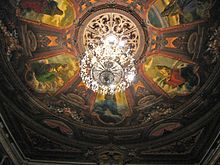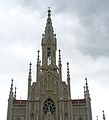- Architecture of Colombia
-
Despite Colombia's multiple cultural heritage (European, Indian and African), its architecture is mostly the result of adapting European models to local conditions. The country's colonial buildings reflect their Spanish (and particularly Andalusian) origin, as seen in the traditional single-story houses laid around a central patio, to be found both in colonial towns such as Santafé (Bogotá), Tunja or Cartagena, or in rural haciendas throughout the country. After gaining its independence, Colombia severed its links with Spain and looked elsewhere for new models, first England, then France,[1] marking the beginning of what became known as Republican Architecture (Arquitectura republicana), an era that lasted well into the twentieth century, when the changes in architectural thinking in Europe brought Modern Architecture to the country during the last years before World War II.
Contents
Pre-Columbian period
Colonial period
Colombian architecture reflects seventeenth century Spanish colonial origins. Regional differences derive from those found in Spain. Thus, hints of Moorish and Castilian architecture are evident in many cities. Many areas have had difficulty maintaining older structures, and the climate has destroyed many Baroque buildings. The many churches that dot the landscape are among the country's architectural gems, whose interiors reflect the influence of Medieval and Renaissance churches in Spain. Newer buildings in larger cities utilize modern styles with adaptations of the Baroque style supplemented with wood and wrought-iron elements.
Republican (Republicano) Period
Modern architecture in Colombia
In the 1930s, Colombia began to embrace modern architecture. The new Liberal Party government tore down many older buildings to reject the conservative past. In their place, it constructed modern buildings with an international flavor.
Housing developments
Until the mid-1940s, most Colombians lived in single-family dwellings built of cinder blocks and covered with an adobe made of clay, cow manure, and hay. Uncontrolled urban growth due to massive migration from rural areas resulted in hughe informal settlements which make up the bulk of Colombia's housing problem up to the present time. Nonetheless, there have been a few notable examples of high-density housing projects (aimed, however, at the rising middle-classes) such as the Centro Antonio Nariño, which followed the principles of Le Corbusier, or the Torres del Parque by the famed architect Rogelio Salmona.
Gallery
Cathedrals
-
The Metropolitan Cathedral of Medellín.
-
The archbishopric cathedral of Bogotá, by Domingo de Petrés, 1792. Neoclassic style.
-
San Ignacio church by Fray Luis Gutierrez. Medellín, 1803.
-
Manizales Cathedral.
-
Salt Cathedral of Zipaquirá, 1995 (detail).
-
Our Lady of Lourdes church, Bogotá, 1875 is an example of gothic architecture.
-
Virgin Mary, Queen of Barranquilla Cathedral
Buildings
Some of the most important buildings in Colombia are:
-
Horizon Building. Cartagena. 140 metres (459 ft) high.
-
Escollera Tower. Cartagena. 206 metres (676 ft) high.
-
Colpatria Tower. Bogotá. 196 metres (643 ft) high.
Historic heritage
Bogotá
-
La Candelaria neighborhood, Bogotá.
-
Camarín del Carmen Theatre, Bogotá, 1625.
Medellín
Cartagena-Santa Marta
-
San Felipe de Barajas Fortress, Cartagena.
-
San Pedro Alejandrino, death place of Simón Bolívar, Santa Marta.
Cúcuta-Villa del Rosario
-
House of Francisco de Paula Santander, Cúcuta
-
Julio Pérez Ferrero Library, Cúcuta
-
Historic Temple of Villa del Rosario, Villa del Rosario
Landmarks
-
Maloka Museum, Bogotá.
Guadua architecture
-
Main tower, Colombian National Coffee Park .
Architectural styles in Colombia
Colonial architecture in Colombia
-
Colonial facade at Santa Fe de Antioquia
-
Colonial facade at Santa Fe de Antioquia
-
Clock Tower, Popayan
-
Spanish Inquisition Palace, Cartagena
-
Pedro de Heredia Theater, Cartagena
Neoclassical architecture in Colombia
-
Neoclassical building, Barranquilla
-
Neoclassical building, Barranquilla
-
Neoclassical building, Barranquilla
-
Popayan Cathedral
Romanesque Revival architecture
-
Metropolitan Cathedral of Medellín
-
Metropolitan Cathedral of Medellín, detail
-
Metropolitan Cathedral of Medellín, pulpit
-
Our Lady of Rosary cathedral, Girardota
Gothic Revival architecture
-
Palace of Culture Rafael Uribe Uribe, Medellín
-
Ubate Cathedral
-
Manizales Cathedral
Neo-Mudéjar architecture
Art Deco architecture
-
Cristobal Colon Theater, Barranquilla
References
Categories:- Colombian architecture
-
Wikimedia Foundation. 2010.





















































